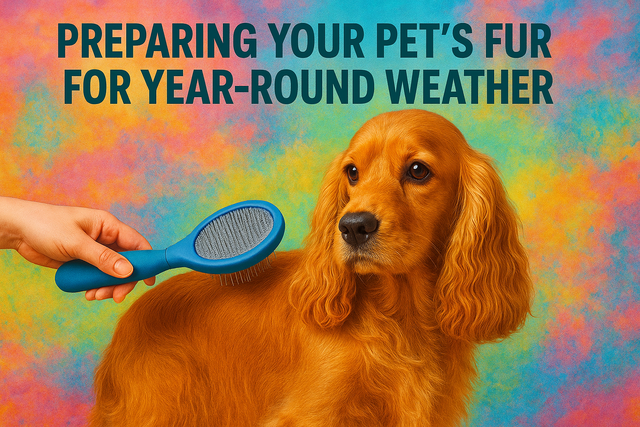
Seasonal Coat Care: Preparing Your Pet’s Fur for Year-Round Weather
As the seasons shift, so do the needs of your pet’s coat. Temperature fluctuations, humidity changes, and varying levels of daylight can all affect fur health, shedding patterns, and skin condition. Thoughtful, season-specific grooming and care not only help your furry companion look their best but also promote comfort and prevent skin issues throughout the year. By understanding the natural cycle of your pet’s coat and tailoring your approach accordingly, you’ll ensure that every season brings out the healthiest, most resilient version of their fur.
Table of Content
Understanding Your Pet’s Seasonal Coat Changes
Pets evolved to grow and shed their coats in response to environmental cues. In colder months, a thicker undercoat traps warmth, while in spring and summer, many animals shed excess fur to keep cool. Breed, age, health status, and even indoor living conditions can influence these natural cycles. For instance, long-haired breeds may develop heavier winter coats, whereas short-haired pets experience subtler changes. Monitoring your pet’s shedding patterns, skin appearance, and behavior, such as increased scratching or restlessness, helps you catch any abnormalities early and adjust your grooming schedule to support healthy coat turnover.
Winter Coat Strategies
When temperatures plunge, your pet relies on its winter coat for insulation. To maintain maximum loft and trapping ability:
- Brush regularly. Use a slicker or undercoat rake two to three times a week to remove loose hairs and prevent matting.
- Moisturize the skin. Winter air tends to be dry, leading to flaky, itchy skin. A moisturizing shampoo formulated with oatmeal or aloe vera can restore hydration without stripping natural oils.
- Protect paws and fur. Snow, ice, and deicing salts irritate paws and can cling to fur. Wipe paws after walks, and consider applying a pet-safe paw balm. A water-resistant coat can also shield the worst of winter’s elements while preventing soaked-through fur that chills your pet.
Addressing Spring and Summer Shedding
As the weather warms, most pets embark on a heavy shed to discard their insulating undercoat. Managing this seasonal molt prevents discomfort, reduces allergens, and keeps your home cleaner:
- Increase brushing frequency. Daily grooming sessions using a de-shedding tool or slicker brush help lift loose hairs before they fall everywhere.
- Hydration and nutrition. Proper hydration supports healthy skin and fur. Look for balanced diets supplemented with omega-3 fatty acids, which can improve coat condition and reduce irritations common during heavy shedding.
- Cool grooming routines. Avoid hot baths in high temperatures. Instead, employ cool or lukewarm water to soothe the skin. After bath time, dry thoroughly to prevent damp fur from trapping heat.
Autumn Preparations and Maintenance
Fall signals a transitional phase: patches of lighter summer fur may give way to new undercoat growth ahead of winter. Proactive care in autumn optimizes your pet’s coat readiness:
- Gentle exfoliation. A soft grooming mitt or rubber curry comb can lightly exfoliate dead cells, stimulating circulation and promoting healthy hair follicles.
- Balanced trimming. For pets with very long hair, a moderate trim can prevent tangles without compromising their ability to grow a full undercoat later.
- Weight and health check. Seasonal coat quality often reflects overall health. A consultation with your veterinarian for weight assessment and bloodwork can uncover nutritional or hormonal issues that might manifest as poor coat condition.
Professional Support and Specialized Services
Sometimes your pet’s needs exceed home grooming. Professional groomers and specialty salons offer targeted treatments that can make all the difference:
- Advanced grooming techniques. From precision deshedding sessions to deep-conditioning treatments, trained professionals can address stubborn mats, excess undercoat, and seasonal skin sensitivities.
- Expert advice. A Seattle dog groomer can recommend breed-specific products, styling tips, and maintenance intervals that align with local climate challenges, whether it’s the damp chill of Pacific Northwest winters or summer heat waves.
Collaborating with a qualified groomer ensures your pet’s coat care strategy remains on track and adapts to evolving seasonal demands.
Conclusion
Year-round coat maintenance is more than a cosmetic luxury; it’s integral to your pet’s comfort, health, and quality of life. By staying attuned to natural shedding cycles, adjusting grooming techniques to seasonal needs, and seeking professional guidance when necessary, you’ll create a comprehensive routine that keeps your companion’s fur shiny, healthy, and perfectly prepared for every change in weather. With consistent care, you’ll both enjoy the simple joy of cuddling into a soft, well-kept coat, no matter the season.


